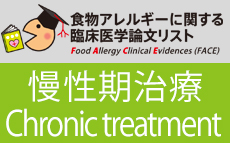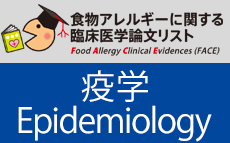Allergen-specific oral immunotherapy for peanut allergy.
更新日:2016年10月21日
| Author: | Nurmatov U, Venderbosch I, Devereux G, Simons FER, Sheikh A. |
|---|---|
| Title: | Allergen-specific oral immunotherapy for peanut allergy. |
| Citation: | Cochrane Database Systematic Review. |
| URL: | https://pubmed.ncbi.nlm.nih.gov/22972130/ |
| Abstract: | BACKGROUND: Peanut allergy is one of the most common forms of food allergy encountered in clinical practice. In most cases, it does not spontaneously resolve; furthermore, it is frequently implicated in acute life-threatening reactions. The current management of peanut allergy centres on meticulous avoidance of peanuts and peanut-containing foods. Allergen-specific oral immunotherapy (OIT) for peanut allergy aims to induce desensitisation and then tolerance to peanut, and has the potential to revolutionise the management of peanut allergy. However, at present there is still considerable uncertainty about the effectiveness and safety of this approach. OBJECTIVES: To establish the effectiveness and safety of OIT in people with IgE-mediated peanut allergy who develop symptoms after peanut ingestion. SEARCH METHODS: We searched in the following databases: AMED, BIOSIS, CAB, CINAHL, The Cochrane Library, EMBASE, Global Health, Google Scholar, IndMed, ISI Web of Science, LILACS, MEDLINE, PakMediNet and TRIP. We also searched registers of on-going and unpublished trials. The date of the most recent search was January 2012. SELECTION CRITERIA: Randomised controlled trials (RCTs), quasi-RCTs or controlled clinical trials involving children or adults with clinical features indicative of IgE-mediated peanut allergy treated with allergen-specific OIT, compared with control group receiving either placebo or no treatment, were eligible for inclusion. DATA COLLECTION AND ANALYSIS: Two review authors independently checked and reviewed titles and abstracts of identified studies and assessed risk of bias. The full text of potentially relevant trials was assessed. Data extraction was independently performed by two reviewers with disagreements resolved through discussion. MAIN RESULTS: We found one small RCT, judged to be at low risk of bias, that enrolled 28 children aged 1 to 16 years with evidence of sensitisation to peanut and a clinical history of reaction to peanut within 60 minutes of exposure. The study did not include children who had moderate to severe asthma or who had a history of severe peanut anaphylaxis. Randomisation was in a 2:1 ratio resulting in 19 children being randomised to the intervention arm and nine to the placebo arm. Intervention arm children received OIT with peanut flour and control arm participants received placebo comprising of oat flour. The primary outcome was assessed using a double-blind, placebo controlled oral food challenge (OFC) at approximately one year. No data were available on longer term outcomes beyond the OFC conducted at the end of the study.Because of adverse events, three patients withdrew from the intervention arm before the completion of the study. Therefore, only 16 participants received the full course of peanut OIT, whereas all nine patients receiving placebo completed the trial. The per-protocol analysis found a significant increase in the threshold dose of peanut allergen required to trigger a reaction in those in the intervention arm with all 16 participants able to ingest the maximum cumulative dose of 5000 mg of peanut protein (which the authors equate as being equivalent to approximately 20 peanuts) without developing symptoms, whereas in the placebo group they were able to ingest a median cumulative dose of 280 mg (range: 0 to 1900 mg, P < 0.001) before experiencing symptoms. Per-protocol analyses also demonstrated that peanut OIT resulted in reductions in skin prick test size (P < 0.001), interleukin-5 (P = 0.01), interleukin-13 (P = 0.02) and an increase in peanut-specific immunoglobulin G(4) (IgG(4)) (P < 0.01).Children in the intervention arm experienced more adverse events during treatment than those in the placebo arm. In the initial day escalation phase, nine (47%) of the 19 participants initially enrolled in the OIT arm experienced clinically-relevant adverse events which required treatment with H(1)-antihistamines, two of which required additional treatment with epinephrine (adrenaline). AUTHORS' CONCLUSIONS: The one small RCT we found showed that allergen-specific peanut OIT can result in desensitisation in children, and that this is associated with evidence of underlying immune-modulation. However, this treatment approach was associated with a substantial risk of adverse events, although the majority of these were mild. In view of the risk of adverse events and the lack of evidence of long-term benefits, allergen-specific peanut OIT cannot currently be recommended as a treatment for the management of patients with IgE-mediated peanut allergy. Larger RCTs are needed to investigate the acceptability, long-term effectiveness and cost-effectiveness of safer treatment regimens, particularly in relation to the induction of clinical and immunological tolerance. |
| 邦文タイトル: | 準備中 |
| 一般向け要約 | 準備中 |
| 専門医コメント | 準備中 |


